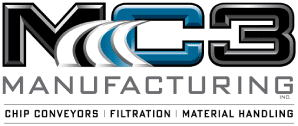Selecting a scrap conveyor for metal stamping scrap removal is different from selecting a conveyor for other applications because metal stamping involves the handling of heavy and sharp materials, which can cause significant wear and tear on conveyor systems. Therefore, conveyors used in metal stamping need to be durable and able to withstand high impact and abrasive forces. A variety of conveyor systems can handle stamping scrap, with hinged steel belt conveyors and magnetic conveyors being two of the most common options.
At MC3 Manufacturing, Inc., we offer a variety of custom fabrication solutions and services. Our custom-fabricated conveyor systems are trusted by customers across a wide range of industries. With over two decades of experience fabricating conveyor systems, we can help you implement the right metal stamping scrap removal system based on your needs.
Removing Metal Stamping Material During the Stamping Process
Choosing the right conveyor system for scrap removal during the metal stamping process is important because it affects the efficiency and quality of the process. The right conveyor system can improve production speed, minimize downtime, and reduce the risk of damage to equipment and parts.
Why Remove Metal Stamping Scrap?
Removing metal stamping scrap during the metal stamping and forging process is important for several reasons and is the biggest factor in determining the type of system you need. Firstly, it helps maintain the efficiency and productivity of the process by preventing jams and damage to equipment. Secondly, removing the scrap regularly helps ensure the quality of the end product by preventing contamination and impurities. Finally, removing scrap efficiently and responsibly helps to minimize costs associated with waste disposal and reduces the cost per part produced.
Options for Scrap Removal
Scrap removal in metal stamping can be performed in one of two ways: manual removal or a conveyor system. Manual removal is labor-intensive and poses safety risks, while scrap conveyor systems increase efficiency and reduce risk. Choosing the right conveyor system tailored to your production line can improve material flow, minimize downtime, and prevent equipment and part damage.
Common Causes of Failures in Material Removal Systems
Understanding the common causes of failure in scrap removal systems is important to prevent downtime and ensure a smooth, efficient process.
Excessive Wear and Damage: Hinge Belt Failures
Undersizing the hinge belt scrap system for the end user requirements and a lack of investigation into the application by the scrap system supplier can result in excessive wear and damage. At MC3, we work closely with our customers to gather all necessary information about their application to guarantee a successful outcome.
Excessive Wear and Damage: Magnetic Conveyor Failures
The improper selection of bed material for your application can lead to excessive wear and damage in magnetic conveyors. To mitigate this, our magnetic conveyor features a fully enclosed machine frame to safeguard the chain, magnets, and gear drive from contamination.
Scrap Spilling Outside of Scrap Systems
Poor understanding of scrap dynamics and lack of experience in scrap systems by the supplier can result in scrap spilling. With 20 years of expertise in scrap removal, our team at MC3 is equipped with the knowledge and experience to install efficient under-floor scrap conveyors that effectively remove all scrap from your plant.
Poor Containment of Fluids
Scrap systems with inadequate designs may leak fluid on plant floors, presenting a risk to workers and creating a mess. Fluid leakage indicates damage to the system body or fluid containment mechanism. An effective scrap removal system will collect fluids produced during stamping to allow for proper disposal and drainage.
Overloading
Overloading typically occurs because of the supplier’s poor understanding of application requirements and the amount of scrap the system must be able to handle. Our hinged belt conveyors use reliable safeguards to avoid this issue along with overaccumulation. We advise our clients to indicate the specific pounds per hour, strokes per hour, and/or pieces per hour their systems should handle.
Jams
Scrap falling in a die can jam the conveyor, causing excessive wear on the motor and bearings. A poor understanding of scrap dynamics can contribute to this issue. Hinged belt conveyors or scrap conveyors can prevent jams when properly designed with features such as side guides, guarding, appropriate conveyor speed, conveyor body design for scrap size, and clean-out areas. At MC3, our expertise in the industry and use of proper design features helps avoid jams and excessive wear on the motor and bearings.
Selecting a Material Removal Conveyor
Depending on your application’s requirements, we offer two main types of conveyors for scrap systems:
- Light/Medium Duty Scrap Removal Conveyors: These include conveyors that are shorter in length, such as magnetic conveyors and hinge belt conveyors.
- Heavy-Duty Scrap Removal Conveyors: These systems are larger and highly tailored hinge belt conveyors.
Knowing the size of your scrap and the frequency of press usage helps with scrap removal conveyor selection. Contact our specialists to discuss your specifications, and we’ll help customize a system that meets your needs.
Metal Stamping Material Removal Conveyors from MC3 Manufacturing Inc.
MC3 Manufacturing provides robust and reliable scrap and chip conveyor systems for forging and stamping operations. With over 20 years of experience, we offer customized solutions for large stamped parts that can handle heat generated during the process. We have a close working relationship with our customers, making frequent visits to ensure our systems function optimally, and reliable, ongoing support behind our products. We strive to deliver tailored solutions to meet the customer’s specific needs.
To learn more about how we can provide the most efficient custom scrap removal conveyor for your application, contact us for additional information or request a quote today.



